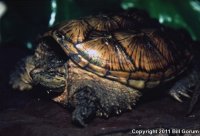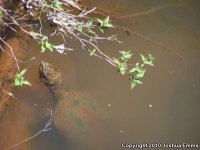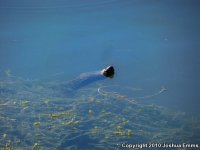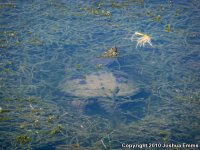Click on a picture to see a larger version in a different window
| Range: |
 The Pecos River Basin and the Rio Grande Basin. The Pecos River Basin and the Rio Grande Basin. |
| Other Names: |
Common Snapper, Eastern Snapping Turtle, Snapper |
| Subspecies: |
Eastern Snapping Turtle Chelydra serpentina serpentina |
| Description: |
A large freshwater turtle with a massive head with huge hooked jaws, a long tail, a saw-toothed crest, and a shell that looks like it is too small to fit the body. The skin is gray, black, yellow, or tan, with tubercles on the neck.
White flecks occur on some individuals. The color of the carapace ranges from black, brown, or olive to tan.
Often it is covered with mud or algae, which helps camouflage the turtle. It is heavily serrated on the rear, and scutes may have a pattern of radiating lines. The plastron is tan or yellow. The legs are large with webbed toes and heavy claws. The tail is longer than half the length of the carapace. |
| Similar Species: |
Small plastron and serrated tail crest distinguishes this turtle from all other species in the state. |
| Habitat: |
Ponds, rivers and stream |
| Behavior: |
Aquatic, found in or near water. An excellent swimmer. Considered most active at night in the southern part of its range, it is apparently more active during the day in the northern part of its range, also. Sometimes seen basking on or under the surface in shallow water. Often rests buried in the mud with its eyes and nostrils exposed in water shallow enough that it can raise its long neck up to allow the nostrils to break the surface and breathe without moving out of the mud. |
| Hibernation: |
Active most of the year, becoming dormant in areas with cold winters, generally in late October. Remains dormant either burrowed into the mud bottom, or under overhanging banks, root snags, stumps, brush, logs, or other debris. Large groups have been found hibernating together, sometimes with other turtle species. Emerges some time between March to May, depending on the climate. |
| Reproduction: |
Adults become sexually mature in four to five years. Females crawl onto land, sometimes travelling over great distances, to dig a nest where they lay a clutch of eggs, generally from 20 - 40, (ranging from 6 - 104). Egg laying takes place mostly in June and July (but can occur any time between May and October). The eggs hatch in 9 - 18 weeks. During cold winters, hatchlings will overwinter in the nest. Females may retain viable sperm for several years, so they do not necessarily need to breed with a male each year to produce viable eggs. |
| Diet: |
Omnivorous, eating anything that fits into its jaws, including snails, earthworms, shrimp, crayfish, insects, fish, frogs, salamanders, reptiles, small turtles, snakes, birds, mammals, plants, and carrion. They can prey on adult waterfowl by grabbing a foot, then grabbing the bird's neck, or pulling it underwater to drown it. (Herpetological Review 48(1), 2017) Young turtles tend to forage actively, while adults tend to lie in ambush. |
Adapted from species account at 
Sources:


|





















